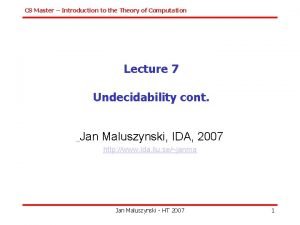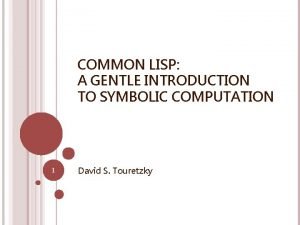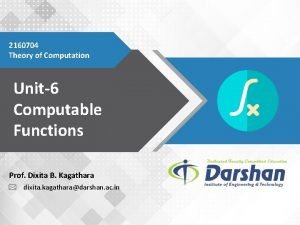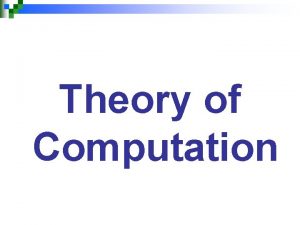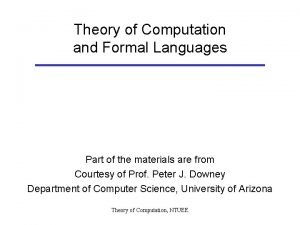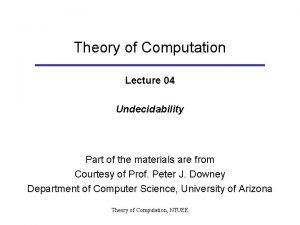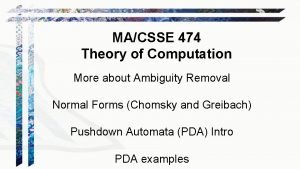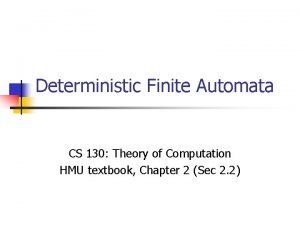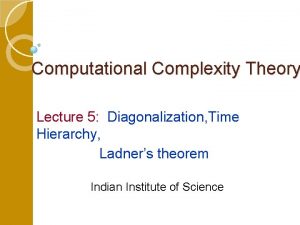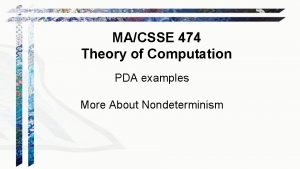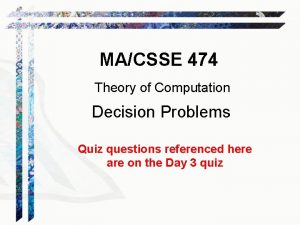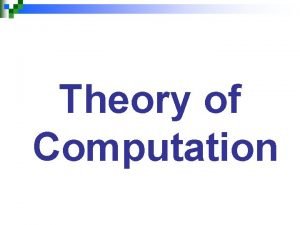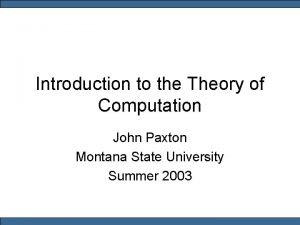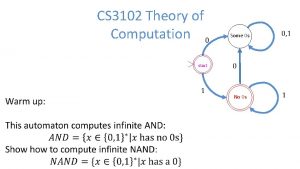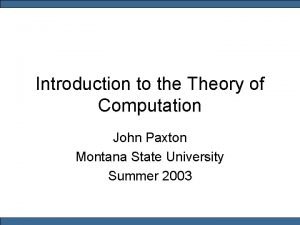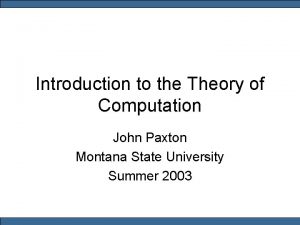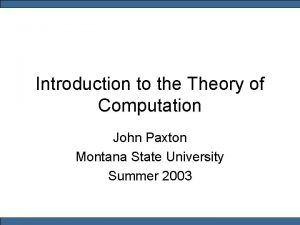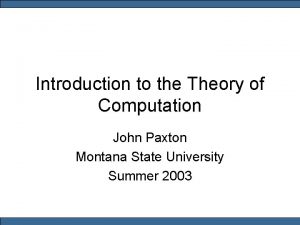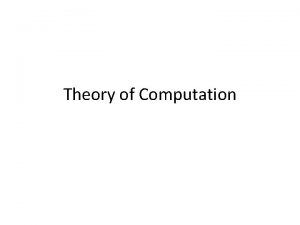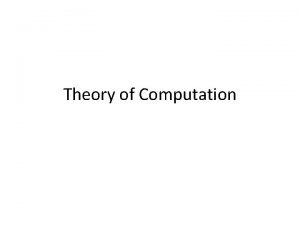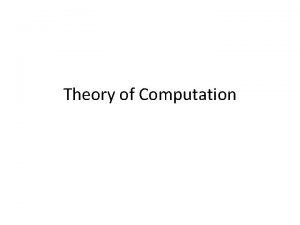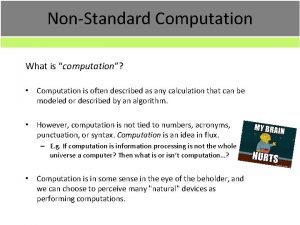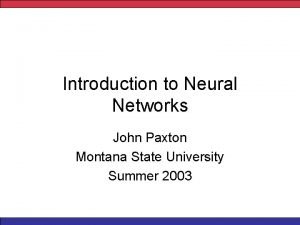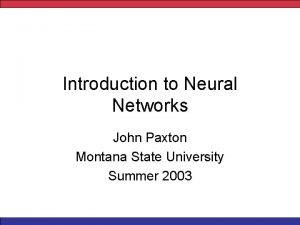Introduction to the Theory of Computation John Paxton


















- Slides: 18

Introduction to the Theory of Computation John Paxton Montana State University Summer 2003

Humor • A little boy, who wanted $100. 00 very badly, prayed for two weeks but nothing happened. Then he decided to write GOD a letter requesting $100. When the postal authorities received the letter to GOD, U. S. A. , they decided to send it to the President. The President was so impressed, touched, and amused that he instructed his secretary to send the boy $50. 00. Mr. President thought that this would appear to be a lot of money to the little boy. The little boy was delighted with the $50. 00 and immediately sat down to write a thank you note to GOD that read: "Dear God, Thank you very much for sending me the money. However, I noticed that for some reason you had to send it through Washington, D. C. , and, as usual, those devil's took half of it.

2. 2 Pushdown Automata • Fundamentally, an NFA with a stack • A recognizer • Equivalent to a Context Free Grammar • A CFG is a generator

PDA Definition • 1. 2. 3. 4. 5. 6. A PDA is a 6 -tuple (Q, S, Γ, d , q 0, F) where Q is the set of states S is the input alphabet Γ is the stack alphabet d: Q x Se x Γe P(Q x Γe ) is transition q 0 is the start state F ≤ Q is the set of accept states

Acceptance • A pushdown automaton M accepts input w if w can be written w 1 w 2…wm where each wi Se and states r 0, r 1, …rm Q and strings s 0, s 1, … sm Γ* exist that satisfy 1. r 0 = q 0 and s 0 = e 2. (ri+1, b) d(ri, wi+1, a) where si = at and si+1 = bt 3. rm F

Example 1 • • • Q = {q 1, q 2, q 3, q 4} S = {0, 1} F = {0, $} F = {q 1, q 4} d(q 1, e, e) = (q 2, $) d(q 2, 0, e) = (q 2, 0) d(q 2, 1, 0) = (q 3, e) d(q 3, e, $) = (q 4, e)

Example 1 0, e -> 0 q 1 e, e -> $ q 2 1, 0 -> e q 4 q 3 e, $ -> e 1, 0 -> e

Exercise • Show a PDA that recognizes the language {aibjck | i, j, k >= 0 and i = j or j = k}. • Draw a picture. • Show it formally, (Q, S, Γ, d , q 0, F).

Exercise • Show a PDA that recognizes the language { ww. R | w {0, 1}* • Draw a picture. • Show it formally.

Theorem: PDAs and CFGs are equivalent • Part 1: If a language is context free, then some pushdown automaton recognizes it. • Part 2: If a pushdown automaton recognizes some language, then it is context free.

Part 1 e, A -> w (for rule A -> w) a, a -> e (for terminal a) qstart qaccept qloop e, e -> S$ e, $ -> e

Part 1 • What about a rule such as A -> a. Bc? e, e -> B e, A -> c qloop e, e -> a

Exercise • Construct a PDA that is equivalent to the following CFG • S -> a. Tb | b • T -> Ta | e

Part 2 • Construct the PDA such that 1. It has a single accept state qaccept 2. It empties its stack before accepting 3. Each transition either pushes a symbol onto the stack (a push move) or pops one off the stack (a pop move), but does not do both at the same time.

Construction • The start variable is q 0 qaccept • The variables are qiqj • if d(p, a, e) contains (r, t) and d(s, b, t) contains (q, e), then add qpqq -> aqrsb • add qpq -> qprqrq for all p, q, r • add qpp -> e for all p

Example 1, revisited 0, e -> 0 q 1 e, e -> $ q 2 1, 0 -> e q 4 q 3 e, $ -> e 1, 0 -> e

Example 1, CFG • • q 11 -> e, q 22 -> e, etc. q 11 -> q 11 | q 12 q 21 | q 13 q 31 | q 14 q 41 q 14 -> eq 23 e q 23 -> 0 q 231 • Example derivation: q 14 -> q 23 -> 0 q 231 -> 00 q 2311 -> 0011

Corollary • Every regular language is context free regular languages context-free languages
 Fish morphology worksheet answers
Fish morphology worksheet answers Autumn vinciquerra
Autumn vinciquerra Donna paxton
Donna paxton Union set operation
Union set operation Is etm recognizable
Is etm recognizable Common lisp: a gentle introduction to symbolic computation
Common lisp: a gentle introduction to symbolic computation Theory of computation
Theory of computation Transition graph examples
Transition graph examples Types of languages in theory of computation
Types of languages in theory of computation Theory of computation
Theory of computation Theory of computation
Theory of computation Theory of computation
Theory of computation Time hierarchy theorem proof
Time hierarchy theorem proof Pda examples
Pda examples Theory of computation quiz
Theory of computation quiz Theory of computation
Theory of computation Dfa to nfa
Dfa to nfa The theory of computation
The theory of computation Uva lookup computing id
Uva lookup computing id




